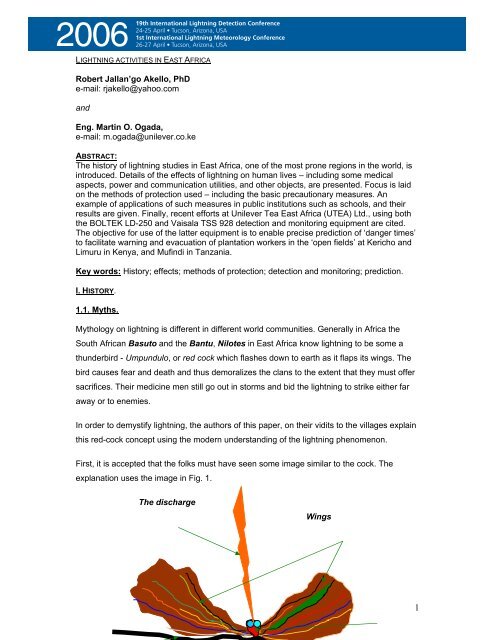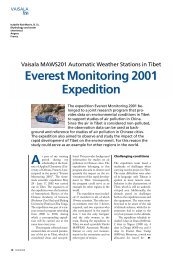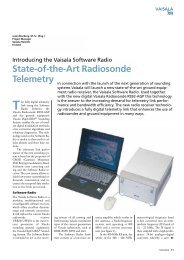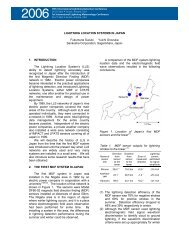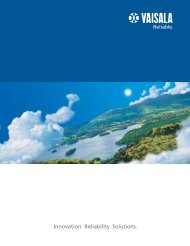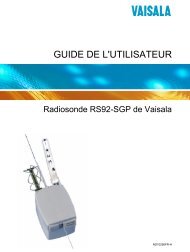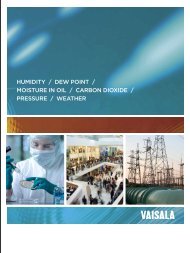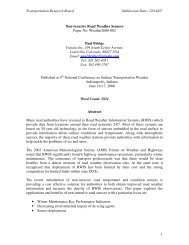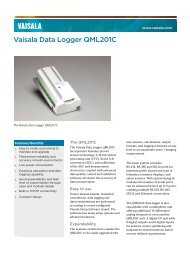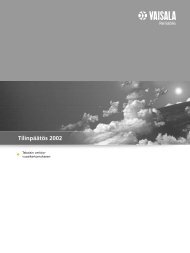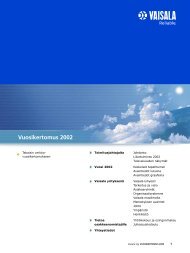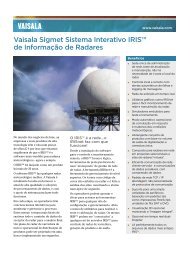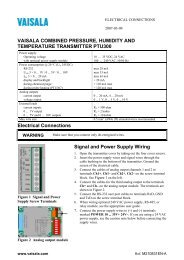Robert Jallan'go Akello, PhD e-mail: rjakello@yahoo.com ... - Vaisala
Robert Jallan'go Akello, PhD e-mail: rjakello@yahoo.com ... - Vaisala
Robert Jallan'go Akello, PhD e-mail: rjakello@yahoo.com ... - Vaisala
- TAGS
- akello
- vaisala
- www.vaisala.com
Create successful ePaper yourself
Turn your PDF publications into a flip-book with our unique Google optimized e-Paper software.
2006 19th<br />
International Lightning Detection Conference<br />
24-25 April Tucson, Arizona, USA<br />
1st International Lightning Meteorology Conference<br />
26-27 April Tucson, Arizona, USA<br />
LIGHTNING ACTIVITIES IN EAST AFRICA<br />
<strong>Robert</strong> Jallan’go <strong>Akello</strong>, <strong>PhD</strong><br />
e-<strong>mail</strong>: <strong>rjakello@yahoo</strong>.<strong>com</strong><br />
and<br />
Eng. Martin O. Ogada,<br />
e-<strong>mail</strong>: m.ogada@unilever.co.ke<br />
ABSTRACT:<br />
The history of lightning studies in East Africa, one of the most prone regions in the world, is<br />
introduced. Details of the effects of lightning on human lives – including some medical<br />
aspects, power and <strong>com</strong>munication utilities, and other objects, are presented. Focus is laid<br />
on the methods of protection used – including the basic precautionary measures. An<br />
example of applications of such measures in public institutions such as schools, and their<br />
results are given. Finally, recent efforts at Unilever Tea East Africa (UTEA) Ltd., using both<br />
the BOLTEK LD-250 and <strong>Vaisala</strong> TSS 928 detection and monitoring equipment are cited.<br />
The objective for use of the latter equipment is to enable precise prediction of ‘danger times’<br />
to facilitate warning and evacuation of plantation workers in the ‘open fields’ at Kericho and<br />
Limuru in Kenya, and Mufindi in Tanzania.<br />
Key words: History; effects; methods of protection; detection and monitoring; prediction.<br />
I. HISTORY.<br />
1.1. Myths.<br />
Mythology on lightning is different in different world <strong>com</strong>munities. Generally in Africa the<br />
South African Basuto and the Bantu, Nilotes in East Africa know lightning to be some a<br />
thunderbird - Umpundulo, or red cock which flashes down to earth as it flaps its wings. The<br />
bird causes fear and death and thus demoralizes the clans to the extent that they must offer<br />
sacrifices. Their medicine men still go out in storms and bid the lightning to strike either far<br />
away or to enemies.<br />
In order to demystify lightning, the authors of this paper, on their vidits to the villages explain<br />
this red-cock concept using the modern understanding of the lightning phenomenon.<br />
First, it is accepted that the folks must have seen some image similar to the cock. The<br />
explanation uses the image in Fig. 1.<br />
The discharge<br />
Wings<br />
1<br />
1
Surface<br />
Head<br />
FIG.1: THE LEGENDARY RED COCK.<br />
On the discharge striking the ground the point of entry is heated to red hot. This is the “head”<br />
of the cock. Since the ground is wet, evaporation occurs and, against the light, the rainbow<br />
colours are seen from one projection. This forms the “wings”.<br />
1.2. Religion and Lightning in Eastern Africa.<br />
When Missionaries reached Eastern Africa, they brought the Bible and taught the locals<br />
about it. The locals who learnt to read the Bible perpetuated the fear of lightning as is<br />
contained in<br />
Exodus 19:16… there were thunders and lightnings… so that all the people that was in the<br />
camp trembled.<br />
Exodus 20:18:16…. people saw the thunderings, and the lightnings… and the mountain<br />
smoking: and when the people saw it, they removed, and stood afar off.<br />
II Samuel 22:15. And he sent out arrows, and scattered them - lightning, and dis<strong>com</strong>forted<br />
them.<br />
Job 28:26…he made a decree for the rain, and a way for the lightning of the thunder:<br />
37:3……. He directeth it under the whole heaven, and his lightning unto the ends of the<br />
earth.<br />
38:25… Who hath divided a watercourse for the overflowing of waters, or a way for the<br />
lightning of thunder;<br />
38:35… Canst thou send lightnings, that they may go and say unto thee, Here we are?<br />
Psalms 77:18……. the lightnings lightened the world: the earth trembled and shook.<br />
Jeremiah 10:13….. he causeth the vapours to ascend from the ends of the earth; he maketh<br />
lightnings with rain, and bringeth forth the wind<br />
Ezekiel 1:13… the fire was bright, and out of the fire went forth lightning.<br />
Dan1:6…. his face as the appearance of lightning<br />
Nahum 2:4…, they shall run like the lightnings.<br />
Zechariah 9:14… his arrow shall go forth as the lightning:<br />
Matthew 24:27…as the lightning <strong>com</strong>eth out of the east, and shineth even unto the west; so<br />
shall also the <strong>com</strong>ing of the Son of man be<br />
Luke 10:18… I beheld Satan as lightning fall from heaven<br />
Revelation 4:5... out of the throne proceeded lightnings and thunderings and voices<br />
2<br />
2
:16:18 … there were voices, and thunders, and lightnings; and there was a great<br />
earthquake, such as was not since men were upon the earth<br />
All these verses stress on the power of lightning and reflect that it is to be feared.<br />
1.3. Modern Concepts<br />
Understanding of the modern concepts of lightning in Eastern Africa started with the<br />
development of infrastructure in the early 60’s. It is in this period that teaching of physics in<br />
secondary schools made the then students conceptualize static and the related electric<br />
discharges in laboratories. This was extended to practical situations, making them<br />
appreciate that lightning is an electrical phenomenon.<br />
The then East African Meteorological Department (EAMD), in collaboration with the World<br />
Meteorological Organization (WMO), mapped out the region, ending up with records of areas<br />
with MTDs of from 15 in the arid areas up to 250 in the mountainous areas around Lake<br />
Victoria. This mapping included all lightning discharges – CG, CC and IC.<br />
II. EFFECTS.<br />
Lightning has caused lots of deaths to both humans and livestock and a lot of damage to<br />
structures such as houses, trees, and power and <strong>com</strong>munication systems.<br />
2.1: Effects on Humans and Livestock.<br />
The largest number of persons and livestock affected by lightning are those who shelter<br />
either under trees or in verandas. In East Africa, apart from those in open fields, it is<br />
<strong>com</strong>mon to see people shelter in these sites especially in schools and market places.<br />
2.1.1: Influences of Earth Resistances and Physical Relief.<br />
Open field casualties have been experienced in the fields of the Brooke Bond Tea<br />
Companies (now UNILEVER Tea Co. Ltd.). Examples are drawn for two sites in Mabroukie<br />
and Mufindi as is depicted below.<br />
Investigations at Mabroukie were based on the earth resistances, indicated in blue. It was<br />
evident that the casualty, not at the biggest height, was on a relatively wet ground with the<br />
lowest resistance of 46 Ω.<br />
F4<br />
Reducing gradient<br />
●301<br />
F3 ●210<br />
3<br />
3
F2<br />
●320<br />
46<br />
●203<br />
F1 Casualty location<br />
FIG 2a: MABROUKIE SITE.<br />
The cloud was approaching from the Rift Valley side and was just uplifted above the<br />
escarpment. It therefore at a relatively low height and discharged on a slanted path<br />
illustrated below.<br />
Cloud<br />
Slanted discharge path<br />
Mabroukie Estate<br />
Casualty<br />
Escarpment<br />
Rift Valley<br />
FIG.2b: SLANT PATH DISCHARGE.<br />
Mufindi in Tanzanian Southern Highlands grows tea by irrigation. It has many man-made<br />
lakes for harvesting water. These lakes <strong>com</strong>plicate the internal climate. Coupled with this is<br />
its location, being surrounded by escarpments. The micro-climate is therefore mot as<br />
predictable as in Mabroukie.<br />
Escarpments<br />
Mufindi Estates<br />
Fig.2: MUFINDI LAYOUT<br />
At Mufindi, therefore, lightning can occur at any time in the year. Since the estates stretch to<br />
the edges of the escarpments, most vulnerable are the tea-pluckers in the fields bordering<br />
the escarpments. Most casualties have therefore been reported from these fields.<br />
4<br />
4
Soil probes for earth resistances followed the same pattern as those for Mabroukie,<br />
indicating casualties on low resistance points.<br />
2.1.2: Medical Aspects:<br />
A. Age:<br />
From available statistics, most casualties are children. This could be explained from cell<br />
activity in children. Of the children casualties in schools, the majority are the average and<br />
bright pupils. This makes villagers suspect witchcraft.<br />
B. Internal Damage:<br />
Post mortems carried out have revealed that some casualties have been found without<br />
tongues, penis and tips of fingers, all being sensory organs. Our explanations of these are<br />
high concentration of lightning currents in these organs, leading to intense heating of tissues<br />
and eventual tissue migration in the process of the current exiting the bodies.<br />
Locals who slaughter livestock struck by lightning have reported “charcoal” found in the<br />
bodies. Our explanation of this is the rupturing of the blood vessels leading to internal<br />
hemorrhage and eventual heating of the clotted blood which, under the body pressure and<br />
constricted volume, lead to the blood hardening and blackening.<br />
C. Survivors:<br />
Some survivors of lightning have changed behaviour patterns either die to the effects of the<br />
brain of dysfunction of the vital hormone glands.<br />
With awareness on such damage increasing quantification, in terms of dollars, has started in<br />
Utility <strong>com</strong>panies. Furthermore, deaths caused by lightning are now getting recorded I the<br />
departments of Births and Deaths, in collaboration with the doctors and the police.<br />
In Kenya, the National Lightning Committee is dormant due to lack of funds but private<br />
<strong>com</strong>munication between members with the related authorities is keeping the records<br />
updated. The members of the Committee include atmospheric physicists, meteorologists,<br />
electrical and electronic engineers, material engineers, mathematicians, geologists,<br />
botanists and foresters, zoologists and veterinarians and medics.<br />
2.1: Effects on Power, Electronic and Tele<strong>com</strong>munication Infrastructure.<br />
The equipment are either totally destroyed or temporarily disabled by lightning. Since these<br />
systems are inter-dependent, lightning effects finally increases downtimes in industries and<br />
banks.<br />
2.3: Effects on Other Objects.<br />
5<br />
5
Houses, trees and rocks are either burnt or split and uprooted by lightning.<br />
Most vulnerable are the highly flammable grass thatched houses and rocks with no traces of<br />
conducting minerals. Soft bark trees without capillaries on them are less affected. Of this lot<br />
is the eucalyptus.<br />
III. METHODS OF PROTECTION.<br />
The protection is undertaken for<br />
3.1: Buildings:<br />
Lightning Conductors (LCs) are provided especially to buildings. Initially, people got this<br />
concept from observations of the colonial buildings. They therefore erected some sort of<br />
protection with a sharp metal on the building, with a down conductor to the earth. These LCs<br />
were therefore not professionally designed.<br />
Professional design started with the appreciation of Standard Codes of Practice. The<br />
Kenyan Code of Practice was developed by the National Lightning Committee in 1989. It is a<br />
<strong>com</strong>bination of many standards which were available at that time. Initially, it re<strong>com</strong>mended<br />
that the designs be based on the Faraday Cone but was later changed to be on the Rolling<br />
Sphere Concept.<br />
The handicaps are that first, there is no Enforcing Agency to ascertain that the Code is<br />
followed. Secondly, there is no regular maintenance for both the down conductors and the<br />
earthing.<br />
Finally, there are <strong>com</strong>panies, such as HELITA of France and Lightning Eliminators Inc. of the<br />
USA respectively marketing LPSs such as the PULSAR Series and Dissipators in the East<br />
African market. The effective superiority of these LPSs seem not to be proven<br />
internationally, ore so in East Africa, where there are no test facilities for confirmation of the<br />
performance characteristics of the LPSs.<br />
3.2: Power Infrastructure.<br />
Power lines in East Africa is transmitted at 220, 132, 66, 33 and 11 kV and distributed at<br />
240V. These traverse areas with large populations.<br />
Most affected are Surge Diverters at 11kV and 240V leading to long term vulnerability of<br />
transformers at these levels. Table 1 below indicates the transformers damaged over a<br />
period of the past 5 years.<br />
YEAR REGION SDs TRANSFORMERS<br />
2001 Western 15 7<br />
6<br />
6
It is evident that:<br />
Rift 7 4<br />
Central 5 3<br />
Coast 4 1<br />
Eastern 1 0<br />
2002 Western 2 1<br />
Rift 0 0<br />
Central 1 0<br />
Coast 0 0<br />
Eastern 0 0<br />
2003 Western 6 3<br />
Rift 2 1<br />
Central 0 0<br />
Coast 0 1<br />
Eastern 0 0<br />
2004 Western 2 1<br />
Rift 1 0<br />
Central 0 0<br />
Coast 0 0<br />
Eastern 0 0<br />
2005 Western 2 1<br />
Rift 0 0<br />
Central 0 0<br />
Coast 0 0<br />
Eastern 0 0<br />
� The largest damage is in Western Kenya, with the highest lightning prevalence<br />
� The number of damage is reducing with time. This is due to more stringent<br />
protection employed. For 2002, there was drought, when lightning was rare.<br />
It is further suspected that the SDs are damaged mainly due to lower specifications in the V/I<br />
– t characteristics.<br />
In the Coast, salt deposition on both the lines and SDs, and the humid atmosphere cause<br />
frequent over-flashing during lightning.<br />
The cited damage cause colossal losses to industries. At the Coast, apart from affecting<br />
lighting in hotels, ventilation is affected and stored foodstuffs are destroyed. This has caused<br />
industries to invest heavily in standby power.<br />
An example is that of the British American Tobacco (BAT) plant at Thika. A SD protecting an<br />
oil Circuit Breaker (OCB) was damaged by lightning. It was not noticed in time but the OCB<br />
was replaced by an SF6 CB. Since it was not protected by the open CB, it was also<br />
damaged by a subsequent lightning discharge.<br />
With the increasing density of electronic equipment, consumers are be<strong>com</strong>ing more aware of<br />
the dangers posed by Switching Surges (SSs) and lightning. More protection at the internal<br />
7<br />
7
levels is therefore increasing using TRansient Absorbers (TRABs) such as those from<br />
PHOENIX and DEHN + SOHNE of Germany.<br />
3.3: Electronics and Tele<strong>com</strong>munication Equipment.<br />
With miniaturization of electronic equipment, they are be<strong>com</strong>ing more sensitive to lightning.<br />
TRABs are therefore getting increasingly installed for protection.<br />
Most damage is to overhead cables in the most prone regions. The current then traverses<br />
the lines to the equipment, which hardly has adequate protection.<br />
Due to long outages of the telephone lines, most business is carried out through cell phones<br />
and direct satellite links.<br />
IV. PREDICTION.<br />
It may be of interest to know that in the very lightning prone areas, there are persons whose<br />
bodies can react to the electrostatic field developed between the cloud and the ground before<br />
the actual discharge takes place. On good observation, it is also possible to see calves,<br />
chicken, goats and sheep changing their behaviour. For example, a strong electrostatic field<br />
may cause the hair of the calves and the feathers of fowl to stand, prompting their jumping,<br />
abrupt running etc.<br />
Although the basic precautionary measures are spelled out, humans, being naturally inhibited<br />
in behavioral patterns, find it difficult to predict lightning occurrences all time. This therefore<br />
calls for the use of detectors.<br />
V. DETECTION AND MONITORING.<br />
The main organization which monitors lightning occurrences is the Meteorological<br />
Department. Their prediction has however not been accurate due to lack of precise<br />
equipment. Currently, the Met Organizations, with the assistance of the WMO, are installing<br />
lightning detection radars.<br />
Recently, UNILEVER, due to its stringent policy on safety of personnel in the fields, has<br />
started monitoring lightning, with a view of evacuating the personnel in time before the<br />
discharge.<br />
Initial efforts were carried out using the hand-held detectors, which were very erratic in their<br />
operation. Finally, BOLTEK LD-250 and <strong>Vaisala</strong> TSS 928 detection and monitoring<br />
equipment were installed at Mabroukie on experimental basis. No results were obtained<br />
8<br />
8
since this was during a dry period. It was therefore decided that the equipment be re-located<br />
to Mufindi, where results are now being seen.<br />
VI: CONCLUSIONS.<br />
Simple measurements using earth resistance testers have indicated the worst points to be<br />
on at dangerous times.<br />
Presentations of the results from Mufindi measurements will be presented when they<br />
be<strong>com</strong>e conclusive. There is need to form networks of such studies for purposes of<br />
advanced warning so as to save lives. This calls for international collaboration and<br />
assistance to the developing countries, which happen to be most lightning prone, in the form<br />
of equipment donations.<br />
<strong>Robert</strong> Jallan’go <strong>Akello</strong> is a Professor of Electrical and Communications Engineering. He<br />
re-located to Western University, College of Science and Technology, P.O. Box 190,<br />
KAKAMEGA from the University of Nairobi,Kenya, where he taught since 1971. He is also a<br />
Consultant to The Kenyan Government and the affected <strong>com</strong>panies on Electrical Safety,<br />
Energy and The Environment.<br />
and<br />
Eng. Martin O. Ogada is the Electrical Engineering Manager, Unilever Tea East Africa Ltd.,<br />
P.O. Box 20, KERICHO. Kenya.<br />
9<br />
9


